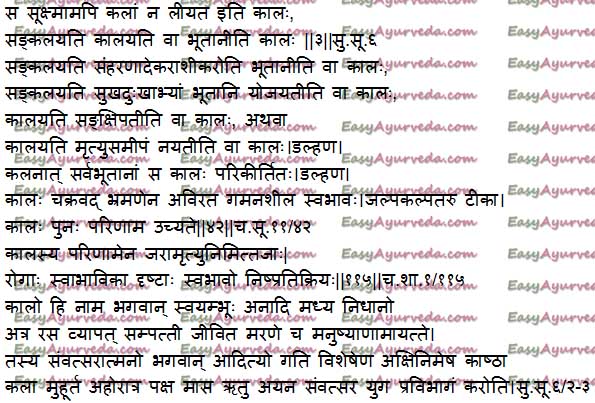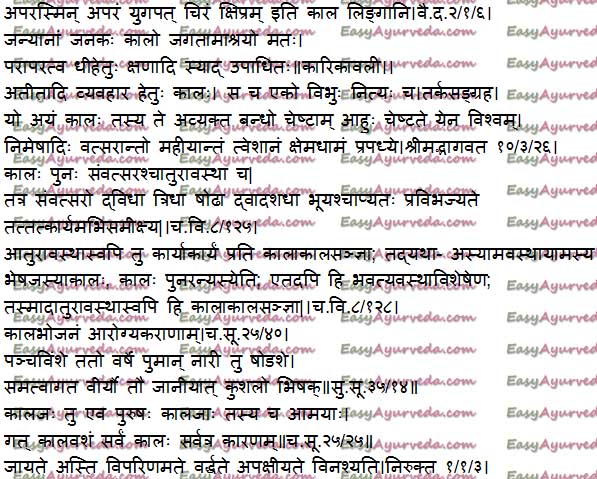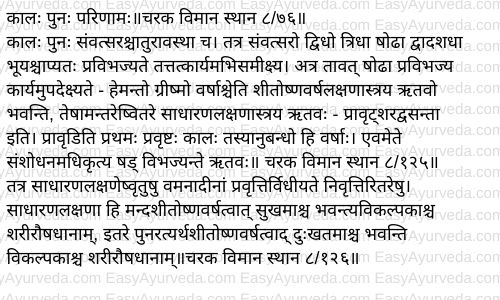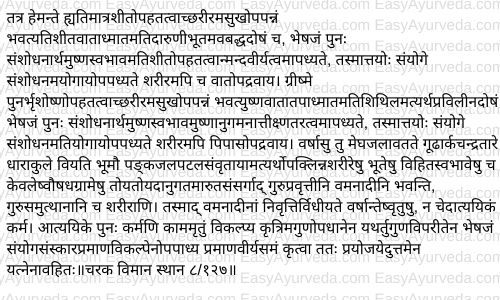Kala – The Time Factor
By Dr Raghuram Y.S. MD (Ay) & Dr Manasa, B.A.M.S
Time is a witness for the evolution and all sorts of transformation. The ageing process we undergo, the ripening of a fruit, the change of seasons, the evolution, the past, present and future, everything is under the control of the time. Time is such a vital entity in all our lives.
Read – Dakshinayana or Visarga Kala (Southern Solstice) Definition, Seasons, Health Effect
Time is the longest distance between two places – Tennessee Williams
Table of Contents
Time is a substance
Time is one among the nine substances mentioned in Ayurveda. A substance is that which has embedded in it its qualities and actions in an inseparable relationship. Time too has its own qualities and actions within it and hence qualifies to be a substance.
Read – Dravya: Meaning, Ayurvedic Explanation
Time is one, not many
Time is virtual and formless, just like ether element and direction. Thus, the time is one, devoid of parts and branches, all pervading and constant (eternal). But virtually, by peculiarity and deceit it appears to be many.
Read – Substances, Qualities, Action – 9 Ashtanga Hrudaya Sutrasthana
A man who dares to waste one hour of time has not discovered the value of life – Charles Darwin

Qualities and signs of time
Time has motion
Since time has motion and is always moving, it doesn’t get dissolved even in the smallest of the atoms.
Time accumulates, counts, creates, kills, reduces life span, associates one with happiness and grief of all living beings
Master Sushruta tells – The time factor is that which accumulates and takes a count of all living beings.
Elaboration by Master Dalhana, the commentator of Sushruta Samhita –
Time is that which kills all living beings and heaps them up.
Time is that which associates everyone with their part of happiness and grief.
Time is that which reduces the lifespan of all living beings.
Time is that which takes everyone close to the death.
Time is that which is responsible for creation of all life.
Time is said to be in constant motion because it keeps rotating and spinning just like a wheel.
‘Time is an illusion’ – Albert Einstein
Read – Uttarayana – Adana Kala (Northern Solstice) Definition, Seasons, Effect On Health
Time is transformation
Time is equivalent to transformation
Time is a form of transformation i.e. time is that which causes transformation. On the other hand, transformation also takes place in relation to time.

Due to the transformation and maturation of time itself the old age induced and death inducing diseases look naturally occurring. Since they are natural diseases occurring with time, they are incurable. Hunger, thirst, old age, death and sleep are also natural diseases which occur with maturity of time or at their proper time.
Read – Sleep Physiology, Tridosha Effect, Benefits Of Good Night Sleep
‘Time is a created thing. To say ‘I don’t have time’ is like saying, ‘I don’t want to.’ – Lao Tzu
Time is eternal
Time is eternal, self manifested and responsible for transformation, life and death, manifestation of months, days, seasons, solstices and year
Kala is said to be mahakala i.e. great entity and also swayambhu i.e. that which self manifests. Time is not created or manufactured by something else. The time is eternal. It can neither be created nor destroyed. Time controls the abundance and destruction of the tastes of all substances. This takes place in sync with the transformation process that takes place according to time. Due to the transformation of time the transformation also takes place in the taste of the substances. The tastes are either rich or depleted in the substances as an effect of transformation of time, as it happens in fruits.
Read – Vipaka: Taste Conversion During And After Digestion
No substance is rich in its taste right from the beginning. Example, mango is sour when it is in unripe form. It will also not yield good quantity of juice. But when the same mango ripens (transforms) with time, there is change in color, consistency and taste.
Similarly the birth and death of all people is under the control of time. Since the time is constantly in motion, it doesn’t get dissolute even in the minutest particle.
The division of the year into 12 months, 6 seasons comprising of 2 months each, the solar and lunar solstices depending on the predominant time periods of sun and moon respectively and both solstices completing a year time, the full and new moon depending on the growth and depletion of moon in accordance to the time in a month, all these are dependent on the time factor. Though they look many, it is the same time, only one time which appears in different ways due to its peculiarity of manifestation.
Read – Various Methods of Ayurvedic Food Processing – Ahara Samskara
Time is determinant
Time is determinant of ageing, togetherness, delay and hastiness
Below mentioned are the characteristic features of time –
- The knowledge of youthfulness by seeing a young person, the knowledge of senility by seeing an old aged person etc
- The knowledge of togetherness by seeing things together
- The knowledge of delay (by seeing the things getting delayed or being late)
- The knowledge of quickness by seeing hastiness or fast movements
Read – How To Age Gracefully? Effective Tips For Graceful Aging
The knowledge of ‘here, in this place’ and ‘there, in that place’ etc are considered as qualities of time. With the help of the knowledge of these, the time factor can be known. Kala is that which helps one to know and appreciate the difference between the childhood, youth and senility. The delay or slow passing of time is called chira and fast passing of time is called kshipra, both indicate time. The substance which relates the same incident taking place in two different places simultaneously is called kala or time.
Read – Kala Samprapti – Understanding Pathogenesis On Basis Of Effect Of Time On Doshas
Time is the creator
Time is a creator, shelter and single
Time is the creator of all those materials which can be created. It is a cradle which shelters the whole creation and is responsible for the discriminative intelligence (intelligence which determines which is important and which is not). Though the time is a single entity, it appears to be many on the basis of its peculiarity of appearance and is counted in different names like second, minute, hour, season etc.

Time is the determinant of past, present and future
That which determines past, present and future is called time. It is all pervading and eternal.
Time is responsible for all activities
All the activities taking place in the world are under the control of the activities and motion of time. If there is no motion in time, the creation too would become motionless and immobile.
Read – What Is The Right Time For Food? How Many Meals A Day?
Types of Kala, time
Time is of two types.
1. Samvatsara – year
Here the year is divided into many forms, like
- two solstices of 6 months each
- cold predominant, heat predominant and monsoon predominant
- 6 seasons of 2 months each
- 30 days of a month
- 24 fortnights
- 8 praharas i.e. time period of 3 hours each in a day etc
Read – Relationship Of Doshas With Seasons
2. Atura avastha – stage of the diseased
The time is also useful in medical practice. Depending on the stage of the disease in the diseased, this time is divided into –
- Kala – right time for giving medicine
- Akala – inappropriate time for administration of medicine
In the context of ahara vidhi vishesha ayatana i.e. eating etiquettes, master Charaka has classified time as nityaga and avasthika. Nityaga is related to seasonal compatibility and Avasthika is related to stages of disease and diseased.
Read – 16 Lifestyle Changes Required After You Reach 30 (Your younger years are over. Let’s Face it!)
Classification of Kala
Master Sushruta has given the below mentioned classification of the time period on the basis of the movement and positioning of Sun.
| Time needed to pronounce an alphabet | = | 1 akshinimesha (1 blink of an eye) |
| 15 akshinimesha | = | 1 kashta |
| 30 kashta | = | 1 kalaa |
| 20 1/6 kalaa | = | 1 muhurta |
| 30 muhurta | = | 1 dina ratri (24 hours, 1 day-night |
| 15 dina ratri | = | 1 paksha (fortnight) |
| 2 paksha | = | 1 masa (month) |
| 12 masa | = | 1 samvatsara (year) |
| 2 masa | = | 1 rutu (season) |
| 3 rutu | = | 1 ayana (solstice) |
| 2 ayana | = | 1 varsha (year) |
| 5 varsha | = | 1 yuga |
Importance of the knowledge of time in Ayurveda
a. To understand the importance of consuming food at time
b. To understand the time needed for maturation of tissues in the body
The time period required for the maturation of rasa etc tissues in male is 25 years and in women it is 16 years.
Read – Dhatu – 7 Body Tissues As Explained In Ayurveda
c. To know the importance of passage of time and its effect in enhancing the medicine qualities
Ghee preserved for 100 or more years destroys morbid kapha and vata, is strengthening, conducive to eye and good for brain due to the effect of time.
d. To understand the prognosis of diseases with respect to time
Chronic disorders wherein the disease is in progression since long time is incurable.
Read – How To Make Prognosis Of Disease According To Ayurveda?
e. To know the proper time in which certain treatments should be conducted
Fire cauterisation treatment is contraindicated in summer season.
Read – Ayurvedic Health Tips For Summer Seasonac
f. To understand time factor as one of the causes for manifestation of diseases
Kala Parinama i.e. transformation and maturation of time is one of the three important causative factors for manifestation of diseases.
g. To understand the effect of time in disease manifestation, procreation and in all activities
Time is responsible for manifestation of diseases and for procreation of life. Time is also responsible for accomplishment of all tasks and activities.
h. To understand time factor as determinant of all stages of growth and development of an individual
6 stages which occur in between life and death (including them) is totally under the control of time and occurs in relation and accordance with time factor.
Read – Shat Kriya Kala – ‘Stage-Wise Disease Management’
- Birth following 9 months of intra-uterine stay and development of the fetus
- Coming to existence with manifestation of life signs
- Transformation, growth and development as per stage and age (ageing)
- Continued growth and development
- Deterioration in growth and development
- Death
i. To understand the importance of collecting certain medicines during certain time
It has been indicated that the medicinal herbs shall be collected in the time period of pushya, ashwini or mrigashira star constellations.
Read – Collection And Preservation Of Ayurvedic Herbs
j. To understand the importance of collecting particular parts of plants in particular seasons
Branches and leaves of medicinal plants should be collected in spring season, roots in summer or late winter, bark, tuber and latex in autumn season, flowers and fruits according to the season of their availability and essence in early winter period.
k. To understand the vitiation of doshas in relation to particular seasons
The aggravation of vata takes place in monsoon season, that of pitta in autumn and that of kapha in spring season.
Kala Pariksha – examination of time factor
Kala Pariksha comprises the examination of time factor and season in relation to the disease and diseased. It is the 8th factor to be examined under dasha vidha pareekshya bhavas as per Master Charaka.
Seasons for Shodhana
Among the 6 seasons, Pravrt, Sharad and vasanth are seasons having moderate rain, cold and heat. These 3 seasons are ideal and recommendable for administration of therapeutic cleansing including emesis and purgation. These seasons are comfortable. The body will also be in a good condition. Since the medicines grown and available in these seasons are also not contaminated and have good properties they would not cause any complications when administered.
The other three seasons i.e. monsoon, winter and summer will have excessive rains, cold and heat respectively and are therefore troublesome in nature. These seasons also easily contaminate the medicines and human body.
Read – Relationship Of Doshas With Seasons
Shodhana – Seasons contradicted
The three seasons – Hemantha, grishma and varsha are contradicted for administration of purification therapies.
Hemantha Rtu / Winter
This season will have extreme cold and will trouble the body. The human body would get influenced and filled up by extremely cold air and become dry and rough. The doshas also get blocked inside the body. In such conditions when medicines having hot potency are administered for the purpose of causing cleansing, the medicines too would get influenced by extreme cold in the environment as well as in the body. This would weaken the efficacy of the medicines and subsequently cause ineffective cleansing. As a complication of this many vata disorders get manifested in the body.
Since there will be excessive heat in peak summer, the season is troublesome for the body. The body becomes more flaccid and weak due to the influence of hot air and severe heat of the sun. The doshas too get excessively adhered in the body and become latent. The medicines administered for shodhana would become intensive in action by the influence of excessive heat in the environment. When such hot potency medicines which has become more intense in nature due to the influence of external heat is administered to a body which has been afflicted and debilitated by heat, it causes ‘effects of excessive usage’. This will cause excessive thirst and other complications in the patient.
In rainy season the sky will be covered by clouds and water. The sun, moon and stars are hidden and not visible. The sky too looks translucent and unclear due to continuous rains and water envelope. Water stagnation and accumulation of mud can be evident everywhere on the earth. The human body is also wet and damp. The medicines (medicinal plants) too loose their properties when they come into contact with moist air. Vomiting and other therapies also become futile and will have less or no effect due to the influence of water, cold air and clouds. The body also will become incapable of getting up, sitting or doing any kind of activities.
If really needed and inevitable, cleansing therapies can be administered even in extremes of seasons. But they shall be administered with caution by considering the below mentioned facts –
– These seasons and their impact on body should be understood thoroughly and the purification therapies should be planned accordingly.
– Ideal situations for administration of purification therapies should be created
– Opposite qualities of these seasons should be created
– Specific combinations, methods of processing and preparing the medicines and specific dosages of the same shall be skillfully formulated
– The formulations for cleansing therapies should be planned and formulated according to the strength of the patient
– Utmost caution should be taken in the smallest of the things and the medicines shall be administered carefully
Proper, improper time of administration of medicines and Examination of time factor
As per various conditions of the patient and depending on does and don’t the time factor is classified into two kinds – kala i.e. proper time and akala i.e. improper time.
Example – When one tells ‘it is improper time to administer this medicine in this condition of the patient’ then that particular medicine is contraindicated at the mentioned stage of the disease and at that point of time. It also means that it is the proper time to administer some other medicine in that stage of disease.
These calculations in relation to time have to be done with caution by the physician after having considered various stages of the disease in the patients and having understood them precisely. The stages of disease and the different kinds of states in which the patient is in is also of two kinds i.e. kala and akala.
Read – Roga, Rogi Pareeksha: Examination Of Disease And Patient
Examination of time factor – proper and improper time
In order to administer medicines in the proper way, different stages of the disease need to be examined very regularly. The patient has to be kept under proper and regular monitoring and observance and any changes need to be noted down. This would also give the physician a clue so as to which medicine needs to be given when and which to be avoided. The physician can also judge as to how many times the medicines need to be given in accordance to the stage of disease and state of the patient.
This examination and observance in relation to time factor is very necessary because any medicine administered before proper time or after the proper time of administration will not yield good results. In fact they may also create complications. The success of the medicines is totally dependent on proper time of administration of medicines in relation to various stages of the disease.
Read – How Dose Of Ayurvedic Medicine Is Decided? 7 Factors
Importance of knowing and examining time factor
Time factor is the key component of comprehensive treatment. The below mentioned factors can be considered as part of examination of time factors which form the backbone of treatment.
– Time of manifestation of disease
– Analyzing different stages of disease
– Time of aggravation and pacification of disease and its symptoms- Seasons which cause aggravation and pacification of doshas and diseases
– Proper and improper time for administration of medicines
– Proper seasons for administration of cleansing therapies
For all this, a comprehensive knowledge of time factor is necessary for the physician.
Sanskrit Verses


Kala in terms of research
Time period is a very important aspect of research studies. Cross sectional, case control and cohort study, the forms of analytical research studies can be included under examination of season.
We make inferences in research study, especially for finding out the causes. Finding out the cause from the effect relates to studying and understanding the past and it is nothing but studying the cause in relation to time. This can once again be correlated with the case-control study design i.e. retrospective study.
Similarly we would also assume or infer about the future from something in the past or present. Example, we have causes and we make inferences of the effects which could happen in future. This is trying to understand the future from the present perspective. This relates to studying and understanding the effect in relation to the time factor. This can be readily correlated with cohort or prospective study design. The events which are commonly observed in the present can be correlated with cross-sectional study design i.e. time prevalence study. The time factor also relates to the season in which the research studies are conducted. It should be taken into consideration in epidemiological studies.
Click to Consult Dr Raghuram Y.S. MD (Ayu) – Email / Skype









